Simone Manuel Collecting Medals and Making a Difference
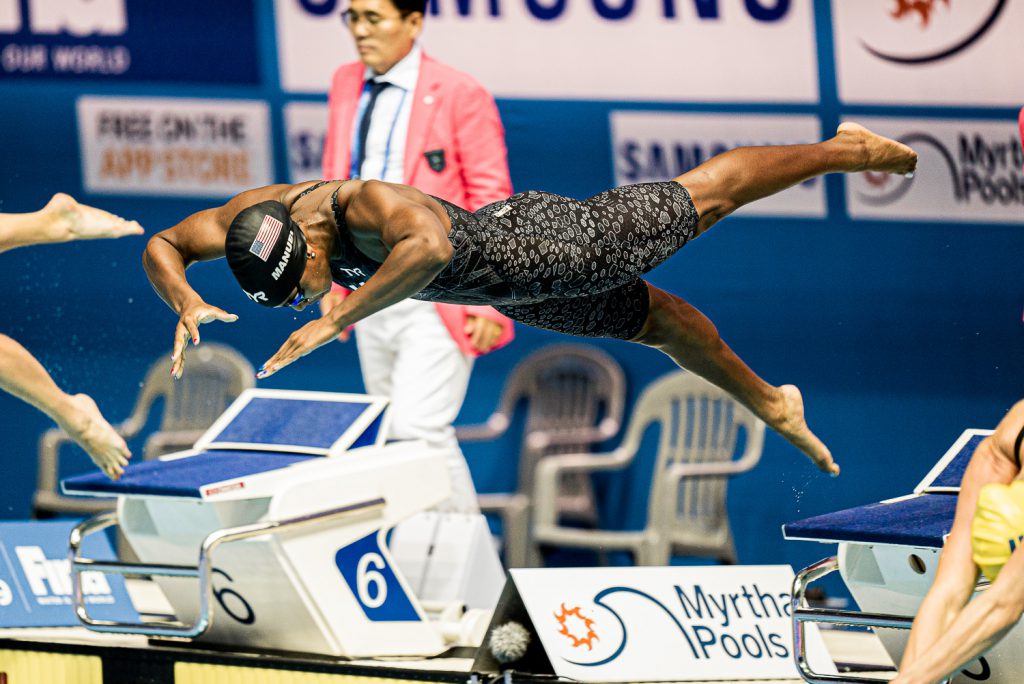
Simone Manuel (From November’s Swimming World Magazine)
Through a constant drive for bettering herself, Simone Manuel has crafted a career for which she may eventually be remembered as the greatest American sprinter ever. But she has forever changed the sport, her impact reaching far beyond any medal she has won. As February continues to celebrate Black History Month, a tribute to Manuel for her influence.
**********
Simone Manuel was down but not done, beaten but not undaunted. She had just anchored the U.S. mixed 400-meter medley relay on the fourth night of the eight-day 2019 World Championships, entering the water with more than a full second advantage on Australian anchor Cate Campbell. But Campbell ran her down (51.10 to 52.37) and stole away the gold medal by a mere 2-hundredths. On the heels of that particularly excruciating performance, her mental fortitude took a big test.
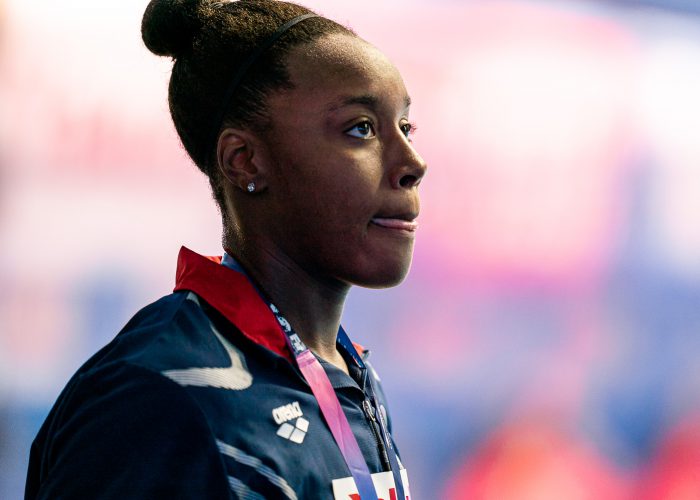
Photo Courtesy: Becca Wyant
All the time, swimmers and coaches preach the importance of managing emotions and attitude, and in that spot, Manuel had to rely on her preparation…and not just the physical part of a long season of training that led her to Gwangju and the World Championships.
“I have nine practices a week every week, and they’re hard,” Manuel said. “To get up in the morning and have to get up and push yourself to be faster than you were the day before—even though you were extremely sore—is no different than a competition and trying to channel all your energy into great swims, even after you’ve had a tough swim or a hard swim or a disappointing swim.”
Indeed, long before the trip to Korea, Manuel ensured that none could ever question her toughness or resiliency. One needed only to glance at her medal résumé for evidence of that. Twice previously, in two enormous moments, Manuel had taken down seemingly unbeatable stalwarts and world record holders to capture gold medals in the 100 free, first Campbell at the 2016 Olympics and then Sweden’s Sarah Sjostrom at the 2017 World Championships.
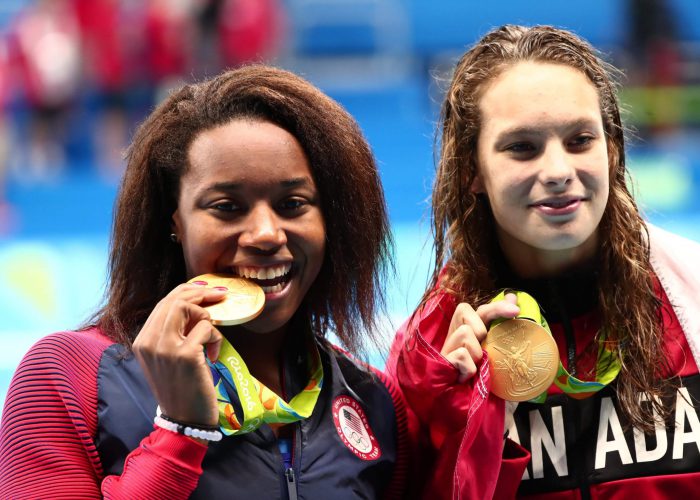
Photo Courtesy: Rob Schumacher-USA TODAY Sports
The Olympic gold had been stunning and surreal—especially as the seemingly unbeatable Campbell abruptly slowed with 20 meters remaining, cracking the door open for Manuel and co-gold medalist Penny Oleksiak to jump through—as well as historic and emotional, as Manuel became the first African-American swimmer ever to capture Olympic gold.
The 2017 World title, meanwhile, may have been just as shocking, as Sjostrom had just set the world record five days earlier at 51.71, a full second faster than Manuel’s lifetime best to that point. Just like the Olympic final, the favorite went out fast and jumped ahead of the field, only for Manuel to track her down and get to the wall first.
Racing to Win
Going into the 100 free World Championships final in 2019, surely Simone Manuel couldn’t do that again, especially not after what Campbell had shown in that mixed medley relay knockout two days prior. And coming out of the semifinals, Sjostrom qualified first, just ahead of Campbell, while Manuel tied for seventh, getting in by just 12-hundredths.
But Manuel had different ideas. On the same day as the 100 free prelims and semifinals, Manuel had recorded the best 200 free swim of her life (1:56.09) by almost a second on a relay leadoff, helping Team USA to finish runner-up in the 800 free relay with an American record 7:41.87—a time that also bettered the previous world record (China, 7:42.08, 2009). And even though she drew Lane 1 for the 100 free final, she truly believed she could win the race.
“I knew what I was capable of going into the meet, just with how I had practiced the whole year,” Manuel said. “I had some high and lofty goals for myself. That’s why the meet itself was somewhat disappointing because I knew I was better than what I had showcased.
“I feel like every time I step on the blocks I have a chance to win. I think it would be a waste of time to step up on the blocks, shooting for second or third or fourth or whatever place besides first. So every time I step up on the blocks, I’m there to win.”
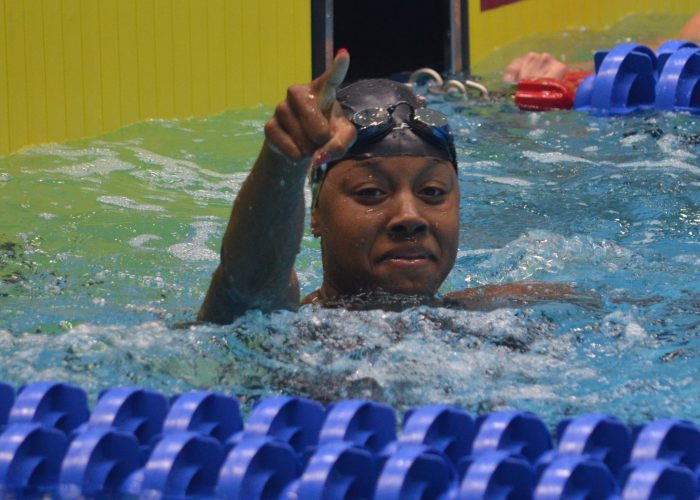
Photo Courtesy: Dan D’Addona
Simone Manuel made those intentions clear right from the start. Best known for her homecoming abilities, Manuel rocketed out to an early lead and flipped 4-tenths ahead of the field at the 50-meter mark, under world record pace. She didn’t cede any ground on the second half and touched in 52.04, an American record and the third fastest time in history. And so, despite every indication that Manuel was given little chance to win, she was suddenly a two-time World champion in the 100 free.
Two days after that, Manuel swam in a 50 free final against Sjostrom, Campbell and Danish Olympic gold medalist Pernille Blume, all of whom had swum in the 23.7-range in 2018. Manuel, meanwhile, owned a lifetime best of 23.97, and she hadn’t been under 24 since 2018. So in any time-based analysis, Manuel was the fourth-best 50 freestyler in that heat.
Again, none of that mattered as Manuel roared to another gold medal, beating out Sjostrom, 24.05 to 24.07. Despite the odds seemingly pointing against her, Manuel had come through with her best performances when the stakes were highest.
“I don’t get too distracted by what other people are doing,” she said. “Obviously, I know what international swimmers are doing, but for me, it’s all about focusing on myself. When I get to those meets, I just race. It ends up being nice because I haven’t spent a lot of energy focusing on, ‘Oh, Sarah’s done this,’ or, ‘Cate’s done this.’ I focus on myself all season, and I think that’s really helpful because I stay on my path and keep pressing forward.”
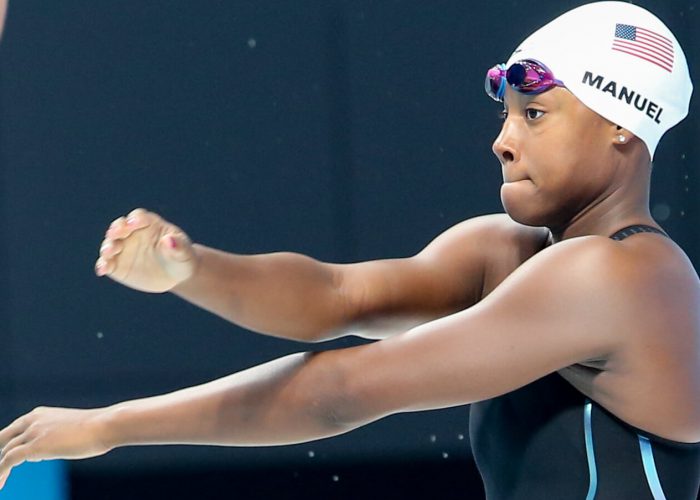
Photo Courtesy: SIPA USA
And as a fitting conclusion to her already stellar performance at the 2019 World Championships—in the meet’s final race, just four events after her 50 free triumph—Manuel joined teammates Regan Smith, Lilly King and Kelsi Dahlia to win the women’s 400 medley relay in 3:50.40, breaking the USA’s previous world record by more than a second. For good measure, she also had the event’s fastest freestyle split with a 51.86.
With the World Championships behind her and the next Olympics now squarely in the forefront, Manuel has returned to the small points, the details that she hopes make the difference as she tries to put herself in position to again swim her best in the big moments. So far this season, Manuel has zeroed in on her freestyle breathing technique, specifically the timing and quickness of her breath, and on strengthening her core to ensure the connectedness of her freestyle.
Even at this point of her career, with such a packed list of accomplishments, it’s the continual process of learning and improving that excites Manuel the most.
“I’m continuing to learn about the sport, learn about what I need to improve on, learn about myself,” she said. “I continue to learn something every day, and I think that’s something I’m really proud of, just because learning more about the sport helps me get better, but also, it’s the reason why I love it so much. Every day, I learn something new.”
An Inspiration to Others
Because of her platform on the sport’s biggest stage, Simone Manuel has opened up swimming to the African-American community on a level never before seen in the United States. Manuel cannot forget the many instances of parents approaching her to say that their son or daughter wanted to join swim lessons because they watched Manuel in the Olympics, and there were even instances of older people joining swim lessons because she had inspired them.
“I think it’s really cool that me swimming up the pool just a couple of times on TV can inspire people to get in the pool and learn how to swim or dream about things that they never thought they possibly could achieve,” she said.
Manuel grew up in a world where African-American swimmers were the exception, and above all else, that’s the change she wants to see in swimming.
“When I was 12 years old, I came home from swim practice, and I asked my mom why there weren’t many people that looked like me in the sport of swimming,” Manuel said. “We did some research, and we looked up African-American swimmers. Obviously, I knew of Cullen Jones and Maritza Correia, but I learned about Sabir Muhammad and Tanica Jamison and so many others who didn’t quite get the recognition that they deserved in the sport.”
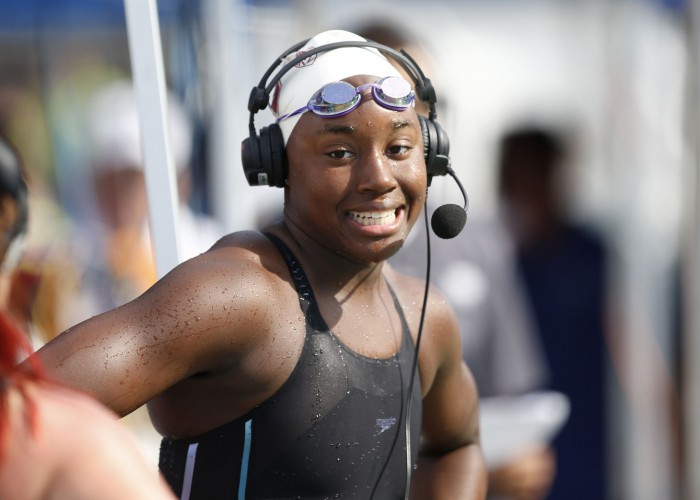
Photo Courtesy: Robert Stanton/USA Today Sports Images
Manuel hopes to help reshape the swimming world so that young African-American swimmers can find more examples of swimmers who look like them. She cringes at any mention of obstacles she still faces due to her race, concerned that such news might turn off African Americans from the sport. Even in swimwear companies’ catalogs and Instagram pages, she resents that models hired to appear alongside sponsored athletes tend to be predominantly white.
“If you start showing some models with African-American children or Asian children or Indian children, then you’re showing people that the demographic is different than just, ‘White people swim,’” Manuel said.
If she’s still an anomaly as an elite African-American swimmer, she hopes for a day when that’s not the case—just like how tennis-playing sisters, Venus and Serena Williams, helped generate huge opportunities for African Americans in their sport and even across all fields. Shortly after the Olympics, Manuel met the Williams sisters at the U.S. Open in New York, an encounter that still resonates with her.
“Just talking to them was a dream come true,” Manuel said. “I really, really looked up to them in my journey in swimming. Just being able to meet them with them knowing who I was and knowing what I have done with something, that was really cool because at that time, I don’t think they really knew that they were such a huge driving force in inspiring me to continue to, essentially, fight the battle that I fight every day.”
And Manuel still sees plenty of room to continue that fight to normalize African Americans in swimming and continue working to provide moments of inspiration for swimmers and non-swimmers of all sorts. She continues to work on new initiatives, particularly with swimwear sponsor TYR, but right now, her most critical work comes in the pool, with another opportunity to showcase her skills and personality to the world at next summer’s Olympics.
* * *
Simone Manuel bristles at being referred to as an “underdog,” especially given the implication that, despite all her success as an African-American swimmer, she still doesn’t belong in the discussion among the favorites. Given her recent history of success, she’s absolutely correct. In-season times don’t matter—results at the end do—and none have better results than Manuel in the sprints over the last four years!
So, yes, watch Manuel in Tokyo as she goes for gold in both the 50 and 100 free as well as four relays, but long-term, the medals will go down as little more than a footnote in her transcendent journey through swimming.




Great article on a great woman!